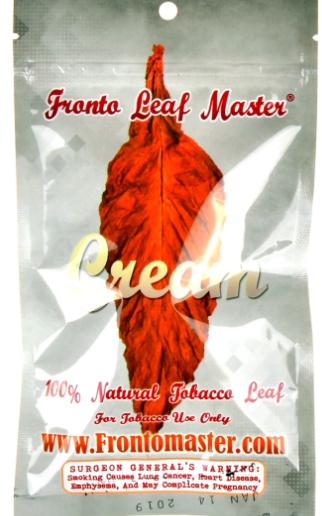Rolling your own tobacco can be a rewarding experience for enthusiasts who appreciate the art of crafting the perfect smoke. One key element that plays a pivotal role in this process is the Fronto leaf, a versatile and distinctive tobacco leaf known for its unique characteristics. In this comprehensive guide, we'll delve into the intricate anatomy and distinctive features of Fronto leaf, offering insights for those who seek a deeper understanding of this essential component in the world of hand-rolled tobacco.
The Origins of Fronto Leaf
To comprehend the essence of Fronto leaf, it's crucial to explore its origins. Hailing from various regions, including the Caribbean and Central America, Fronto leaf is cultivated with precision and care. The rich soil and climate of these regions contribute to the unique flavor profile that distinguishes Fronto leaf from other types of tobacco.
The Anatomy of Fronto Leaf
1. Leaf Structure
Fronto leaves are characterized by their large size and robust structure. The leaves consist of three main parts: the top, middle, and bottom. Each section contributes distinct flavors and burning characteristics to the overall smoking experience.
2. Vein Distribution
Examining the vein distribution within Fronto leaves is crucial for aficionados seeking a customized blend. The veins play a role in flavor intensity and burning consistency. Understanding how to identify and manipulate these veins allows for a tailored smoking experience.
Characteristics that Define Fronto Leaf
3. Flavor Complexity
Fronto leaf is renowned for its complex flavor profile, offering a blend of earthiness, sweetness, and sometimes a hint of spiciness. This diversity in taste is a result of the unique combination of soil composition, climate, and cultivation techniques employed in its growth.
4. Aroma and Fragrance
A distinctive aroma accompanies Fronto leaf, providing a sensory experience that is both invigorating and aromatic. The fragrance is influenced by factors such as the curing process and the natural oils present in the leaves.
Cultivation Techniques and Processing
5. Curing Methods
The curing process is a critical stage in developing the desired characteristics of Fronto leaf. Farmers employ various curing methods, including air curing and fire curing, each contributing distinct nuances to the final product.
6. Fermentation and Aging
Fronto leaves undergo a fermentation and aging process that enhances their flavor and texture. This meticulous method ensures a well-balanced and matured leaf, ideal for the discerning tobacco enthusiast.
Rolling Techniques for Fronto Leaf
7. Choosing the Right Cut
The cut of Fronto leaf is essential for achieving the desired smoking experience. Whether it's a long ribbon cut or a fine shag, the cut influences burn rate, flavor release, and overall satisfaction.
8. Moisture Content
Maintaining the appropriate moisture content is crucial when working with Fronto leaf. Too dry, and it may burn too quickly; too moist, and it could affect the flavor and burn consistency. Finding the perfect balance is an art in itself.
Exploring Fronto Leaf Blends
9. Single Varietal vs. Blends
Fronto leaf can be enjoyed as a single varietal or blended with other tobacco types. Understanding the characteristics of different varietals allows enthusiasts to create a personalized blend that suits their taste preferences.
10. Balancing Flavors in Blends
Creating a well-balanced blend involves experimenting with proportions and combinations. This process allows for a nuanced and layered smoking experience that caters to individual preferences.
The Ritual of Hand-Rolling with Fronto Leaf
11. The Art of Rolling
Hand-rolling with Fronto leaf is an art form that requires practice and patience. Embracing the tactile experience of crafting your smoke adds an extra layer of enjoyment to the process.
12. Achieving the Perfect Pack
Proper packing of Fronto leaf is crucial for an even burn and consistent draw. Understanding the nuances of packing techniques ensures a satisfying smoking experience from the first puff to the last.
Conclusion
In conclusion, understanding the anatomy and characteristics of Fronto leaf is key for those who appreciate the craft of hand-rolling tobacco. From the origins of the leaf to its intricate anatomy and the art of rolling, every step contributes to a unique and personalized smoking experience. Embrace the journey of exploring Fronto leaf, and elevate your tobacco enjoyment to new heights.
Embark on a flavorful journey with Tobacco Stock, where quality meets tradition. Elevate your smoking experience with our premium Fronto leaf for hand-rolled perfection, and explore a diverse selection of Blunt Wraps to customize your smoke in style. Ignite the passion for tobacco craftsmanship - your satisfaction, our promise.
FAQs About Fronto Leaf
1.Can Fronto leaf be used in pre-rolled cigarettes?
Yes, Fronto leaf can be used in pre-rolled cigarettes, providing a distinct flavor and aroma compared to traditional cigarette tobacco.
2.What is the best storage method for Fronto leaf?
The ideal storage method for Fronto leaf involves keeping it in a cool, dark place with controlled humidity to preserve its flavor and moisture content.
3.Are there different grades of Fronto leaf?
Yes, Fronto leaf is graded based on factors such as size, color, and overall quality. Higher grades often command a more premium price.
4.Can Fronto leaf be grown at home?
While it's possible to grow tobacco at home, cultivating Fronto leaf requires specific conditions that may be challenging to replicate outside its native regions.
5.How does the flavor of Fronto leaf compare to other types of tobacco?
Fronto leaf offers a unique and complex flavor profile, distinct from other tobacco types. Its rich, earthy notes combined with hints of sweetness make it a favorite among rolling tobacco enthusiasts.


No comments yet